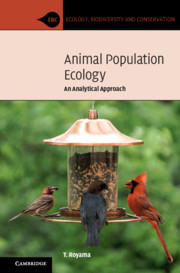Book contents
- Animal Population Ecology
- Ecology, Biodiversity and Conservation
- Animal Population Ecology
- Copyright page
- Dedication
- Contents
- Prologue
- 1 Hunting Strategies of Predators as Revealed in Field Studies of Great Tits
- 2 The Paradox of Crypsis: Is it Effective against Visual Predation?
- 3 Logistic Law of Population Growth: What Is It Really?
- 4 Reproduction Curves and Their Utilities
- 5 Generalization of the Logistic Model
- 6 Scramble and Contest Competition: What Is the Difference?
- 7 Regulation of Populations: Its Myths and Real Nature
- 8 Predator–Prey Interaction Processes
- 9 Interspecific Competition Processes
- 10 Observations, Analyses, and Interpretations: A Personal View through the Spruce Budworm Studies
- References
- Index
10 - Observations, Analyses, and Interpretations: A Personal View through the Spruce Budworm Studies
Published online by Cambridge University Press: 01 April 2021
- Animal Population Ecology
- Ecology, Biodiversity and Conservation
- Animal Population Ecology
- Copyright page
- Dedication
- Contents
- Prologue
- 1 Hunting Strategies of Predators as Revealed in Field Studies of Great Tits
- 2 The Paradox of Crypsis: Is it Effective against Visual Predation?
- 3 Logistic Law of Population Growth: What Is It Really?
- 4 Reproduction Curves and Their Utilities
- 5 Generalization of the Logistic Model
- 6 Scramble and Contest Competition: What Is the Difference?
- 7 Regulation of Populations: Its Myths and Real Nature
- 8 Predator–Prey Interaction Processes
- 9 Interspecific Competition Processes
- 10 Observations, Analyses, and Interpretations: A Personal View through the Spruce Budworm Studies
- References
- Index
Summary
This chapter promotes my methodological thoughts on carrying out an ecological investigation through observations, analyses of data, and interpretation of the results. These are the thoughts that I have conceived while studying outbreak processes of the spruce budworm, Choristoneura fumiferana, in eastern Canada. In particular, I critically examine the early ideas (hypotheses) of the processes in which an outbreak is initiated and is spread over wide areas: namely, the formation of epicentres and the dichotomy of epidemic–endemic states of budworm populations. My re-analyses of the original data reveal that these ideas are neither conceivable theoretically nor substantiated observationally. This finding leads me to delve into methodological fundamentals in ecological studies of populations in general: the amalgamation of empirical and theoretical ecology and how to achieve it.
Keywords
- Type
- Chapter
- Information
- Animal Population EcologyAn Analytical Approach, pp. 252 - 270Publisher: Cambridge University PressPrint publication year: 2021

